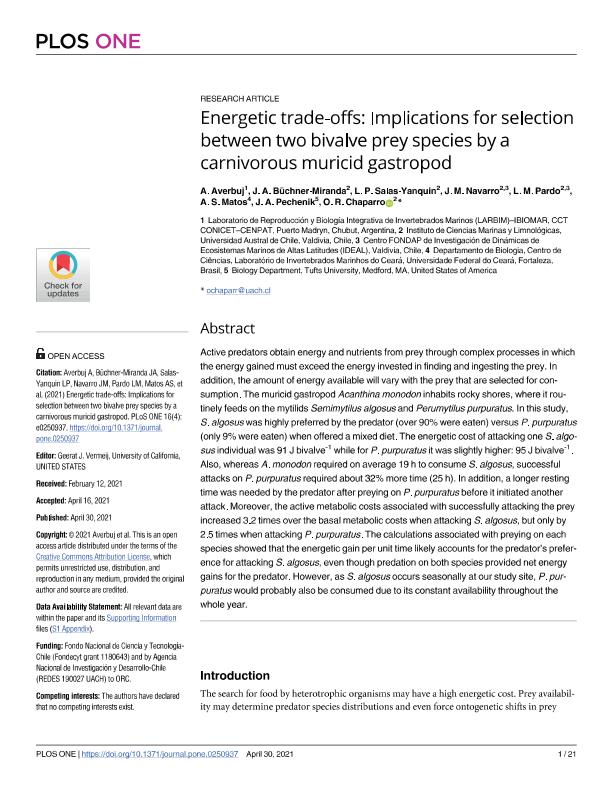Mostrar el registro sencillo del ítem
dc.contributor.author
Averbuj, Andres

dc.contributor.author
Büchner-Miranda, J. A.
dc.contributor.author
Salas-Yanquin, L. P.
dc.contributor.author
Navarro, J. M.
dc.contributor.author
Pardo, L. M.
dc.contributor.author
Matos, A. S.
dc.contributor.author
Pechenik, J. A.
dc.contributor.author
Chaparro, O. R.
dc.date.available
2022-09-09T15:09:31Z
dc.date.issued
2021-04
dc.identifier.citation
Averbuj, Andres; Büchner-Miranda, J. A.; Salas-Yanquin, L. P.; Navarro, J. M.; Pardo, L. M.; et al.; Energetic trade-offs: Implications for selection between two bivalve prey species by a carnivorous muricid gastropod; Public Library of Science; Plos One; 16; 4; 4-2021; 1-21
dc.identifier.uri
http://hdl.handle.net/11336/168133
dc.description.abstract
Active predators obtain energy and nutrients from prey through complex processes in which the energy gained must exceed the energy invested in finding and ingesting the prey. In addition, the amount of energy available will vary with the prey that are selected for consumption. The muricid gastropod Acanthina monodon inhabits rocky shores, where it routinely feeds on the mytilids Semimytilus algosus and Perumytilus purpuratus. In this study, S. algosus was highly preferred by the predator (over 90% were eaten) versus P. purpuratus (only 9% were eaten) when offered a mixed diet. The energetic cost of attacking one S. algosus individual was 91 J bivalve-1 while for P. purpuratus it was slightly higher: 95 J bivalve-1. Also, whereas A. monodon required on average 19 h to consume S. algosus, successful attacks on P. purpuratus required about 32% more time (25 h). In addition, a longer resting time was needed by the predator after preying on P. purpuratus before it initiated another attack. Moreover, the active metabolic costs associated with successfully attacking the prey increased 3.2 times over the basal metabolic costs when attacking S. algosus, but only by 2.5 times when attacking P. purpuratus. The calculations associated with preying on each species showed that the energetic gain per unit time likely accounts for the predator’s preference for attacking S. algosus, even though predation on both species provided net energy gains for the predator. However, as S. algosus occurs seasonally at our study site, P. purpuratus would probably also be consumed due to its constant availability throughout the whole year.
dc.format
application/pdf
dc.language.iso
eng
dc.publisher
Public Library of Science

dc.rights
info:eu-repo/semantics/openAccess
dc.rights.uri
https://creativecommons.org/licenses/by/2.5/ar/
dc.subject
PREDATION
dc.subject
MUSSELS
dc.subject
ENERGETICS
dc.subject
MURICIDAE
dc.subject.classification
Biología Marina, Limnología

dc.subject.classification
Ciencias Biológicas

dc.subject.classification
CIENCIAS NATURALES Y EXACTAS

dc.title
Energetic trade-offs: Implications for selection between two bivalve prey species by a carnivorous muricid gastropod
dc.type
info:eu-repo/semantics/article
dc.type
info:ar-repo/semantics/artículo
dc.type
info:eu-repo/semantics/publishedVersion
dc.date.updated
2022-04-26T17:26:08Z
dc.identifier.eissn
1932-6203
dc.journal.volume
16
dc.journal.number
4
dc.journal.pagination
1-21
dc.journal.pais
Estados Unidos

dc.journal.ciudad
San Francisco
dc.conicet.avisoEditorial
Copyright: © 2021 Averbuj et al. This is an open access article distributed under the terms of the Creative Commons Attribution License, which permits unrestricted use, distribution, and reproduction in any medium, provided the original author and source are credited.
dc.description.fil
Fil: Averbuj, Andres. Consejo Nacional de Investigaciones Científicas y Técnicas. Centro Científico Tecnológico Conicet - Centro Nacional Patagónico. Instituto de Biología de Organismos Marinos; Argentina
dc.description.fil
Fil: Büchner-Miranda, J. A.. Universidad Austral de Chile; Chile
dc.description.fil
Fil: Salas-Yanquin, L. P.. Universidad Austral de Chile; Chile
dc.description.fil
Fil: Navarro, J. M.. Universidad Austral de Chile; Chile. Centro FONDAP de Investigación de Dinámicas de Ecosistemas Marinos de Altas Latitudes (IDEAL); Chile
dc.description.fil
Fil: Pardo, L. M.. Universidad Austral de Chile; Chile. Centro FONDAP de Investigación de Dinámicas de Ecosistemas Marinos de Altas Latitudes (IDEAL); Chile
dc.description.fil
Fil: Matos, A. S.. Universidade Federal do Ceará; Brasil
dc.description.fil
Fil: Pechenik, J. A.. Tufts University; Estados Unidos
dc.description.fil
Fil: Chaparro, O. R.. Universidad Austral de Chile; Chile
dc.journal.title
Plos One

dc.relation.alternativeid
info:eu-repo/semantics/altIdentifier/doi/http://dx.doi.org/10.1371/journal.pone.0250937
dc.relation.alternativeid
info:eu-repo/semantics/altIdentifier/url/https://dx.plos.org/10.1371/journal.pone.0250937
Archivos asociados
